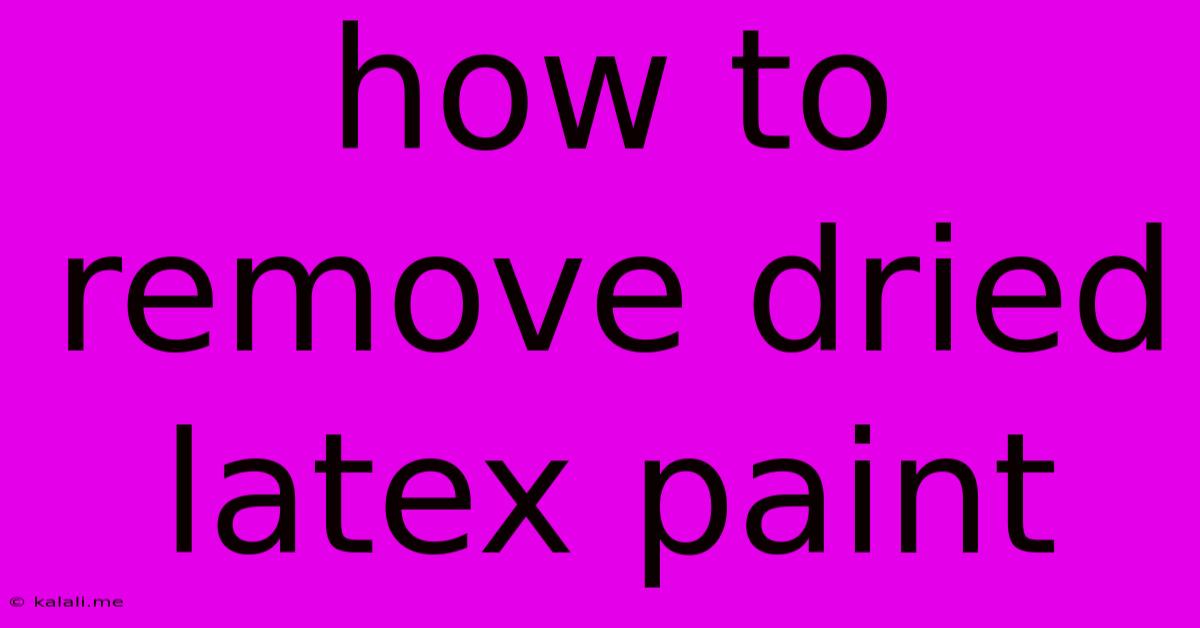How To Remove Dried Latex Paint
Kalali
May 23, 2025 · 3 min read

Table of Contents
How to Remove Dried Latex Paint: A Comprehensive Guide
Removing dried latex paint can be a frustrating task, but with the right tools and techniques, it's entirely manageable. This comprehensive guide will walk you through various methods, helping you choose the best approach for your specific situation. Whether you're dealing with paint splatters on your hardwood floor, a stubborn blob on your window, or a whole wall needing a makeover, we've got you covered. This guide covers everything from simple scraping techniques to chemical solutions, ensuring you can tackle any dried latex paint problem effectively.
Understanding Latex Paint and its Removal Challenges
Latex paint, a water-based paint, is popular for its ease of cleanup while wet. However, once dried, it bonds strongly to various surfaces. The difficulty in removal depends on several factors:
- The surface: Porous surfaces like wood absorb paint more readily, making removal more challenging than on smooth, non-porous surfaces like glass.
- The paint's age: Older, more cured paint is significantly harder to remove.
- The paint's thickness: Thicker layers of paint require more effort to remove.
- The type of surface finish: A glossy surface may be easier to scrape than a matte finish, as the paint doesn't adhere as strongly.
Methods for Removing Dried Latex Paint
Several methods can be used to remove dried latex paint, each with its own advantages and disadvantages:
1. Scraping:
- Best for: Small areas, relatively thin layers of paint, and surfaces that can withstand scraping.
- Tools: Putty knife, paint scraper, plastic scraper (to avoid scratching delicate surfaces).
- Technique: Gently apply the scraper at a low angle to the surface, working carefully to avoid damaging the underlying material. Use a scraper appropriate for the surface being cleaned; a metal scraper on glass or wood could cause damage.
2. Chemical Strippers:
- Best for: Large areas, thick layers of paint, or when scraping is ineffective.
- Tools: Paint scraper, chemical stripper, safety gloves, eye protection, ventilation.
- Technique: Apply the chemical stripper according to the manufacturer's instructions. Let it sit for the recommended time to soften the paint before scraping it away. Always work in a well-ventilated area and wear appropriate safety gear. Remember to neutralize the chemical stripper after use, following the product instructions carefully. This method requires caution, as chemical strippers can be harsh and damaging to some surfaces.
3. Heat Gun:
- Best for: Removing paint from metal or other heat-resistant surfaces.
- Tools: Heat gun, paint scraper, safety glasses.
- Technique: Carefully heat the paint until it softens, then scrape it away. This method requires extreme care to prevent burns and damage to the underlying surface. It's crucial to keep the heat gun moving constantly to avoid overheating any area. Never use this method near flammable materials.
4. Sanding:
- Best for: Removing small amounts of paint from larger surfaces, smoothing rough edges.
- Tools: Sandpaper (various grits), sanding block, dust mask, safety glasses.
- Technique: Start with a coarser grit sandpaper and progressively move to finer grits to achieve a smooth finish. Always wear a dust mask to avoid inhaling paint dust. This is a time-consuming method, best suited for minor paint removal or final smoothing after other methods.
Choosing the Right Method: A Practical Guide
The best method for removing dried latex paint depends on several factors:
- Surface type: For delicate surfaces like wood or glass, scraping or chemical stripping may be too harsh. Sanding is a gentler alternative in many cases.
- Paint amount: Scraping is best for small areas, while chemical stripping or a heat gun (on appropriate surfaces) are better suited for larger areas or thick layers of paint.
- Your skill level: Scraping is relatively straightforward, while chemical stripping and using a heat gun require more experience and caution.
Remember to always test any method on a small, inconspicuous area first to ensure it doesn't damage the surface. Prioritize safety, using appropriate protective gear whenever handling chemicals or using heat tools. With the right approach and careful execution, you can successfully remove dried latex paint and restore the beauty of your surfaces.
Latest Posts
Latest Posts
-
How To Remove Paint From Wood Floor
May 24, 2025
-
Module Load Doesnt Work With Zsh
May 24, 2025
-
Can You Use Gps While Stranded In The Ocean
May 24, 2025
-
Wordpress Function To Reorganize The Admin Menu
May 24, 2025
-
How Long Do Metal Roofs Last
May 24, 2025
Related Post
Thank you for visiting our website which covers about How To Remove Dried Latex Paint . We hope the information provided has been useful to you. Feel free to contact us if you have any questions or need further assistance. See you next time and don't miss to bookmark.